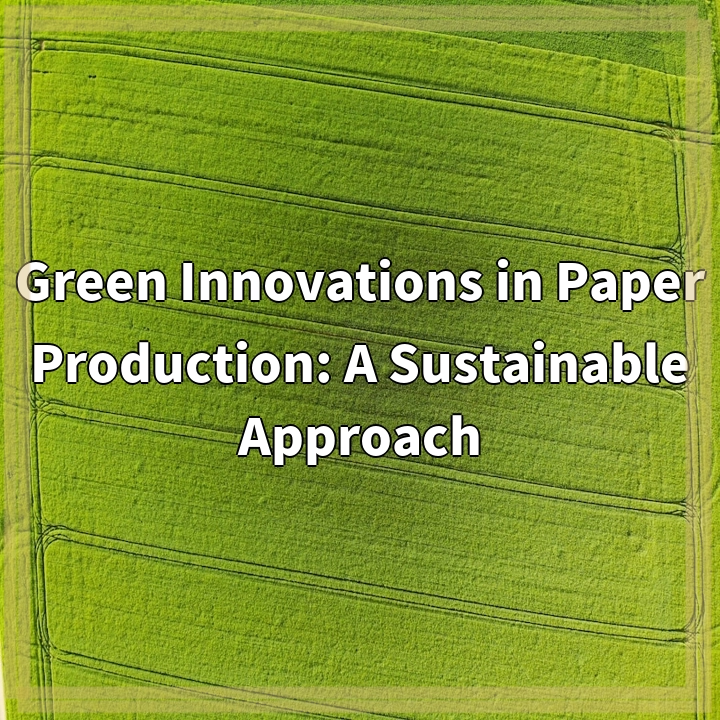
What it is:
Green innovations in paper production refer to sustainable and environmentally-friendly practices implemented in the paper manufacturing process. These methods aim to minimize the ecological footprint associated with paper production, reduce waste, and conserve natural resources.
Real-World Problems:
While the demand for paper continues to rise due to various industries and consumer needs, traditional methods of paper production have detrimental effects on the environment. Some of the key challenges and problems associated with the paper industry include:
Deforestation:
Paper production traditionally relies on wood pulp derived from trees. The high demand for paper has led to the loss of forests, which directly impacts biodiversity, disrupts ecosystems, and contributes to climate change.
Water Consumption:
The paper production process requires significant amounts of water. From the cultivation of trees to the various stages of processing, water is used for pulping, bleaching, and cleaning. This can result in large quantities of contaminated water being discharged, leading to water pollution and depletion of freshwater resources.
Chemical Usage:
In conventional paper mills, chemicals such as chlorine are used in the bleaching process to make the paper bright white. These chemicals can be toxic and have harmful effects on both the environment and human health. They can contaminate water bodies and contribute to air pollution.
Waste Generation:
Paper production generates significant amounts of waste, including sludge, trimmings, and offcuts. Improper disposal of this waste can lead to pollution of air, water, and soil. Additionally, the incineration or landfilling of paper waste contributes to greenhouse gas emissions.
Carbon Footprint:
The entire lifecycle of paper production, from the cultivation of trees to the manufacturing process and transportation, contributes to carbon dioxide emissions. This exacerbates climate change and global warming.
To address these real-world problems, various sustainable and innovative approaches have been developed within the paper industry. These approaches aim to reduce deforestation, water consumption, chemical usage, waste generation, and carbon emissions. By adopting environmentally-friendly practices and technologies, the paper industry can move towards a more sustainable and responsible future.

Solutions to Real-World Problems in Green Innovations in Paper Production:
Addressing the environmental challenges associated with paper production requires the implementation of sustainable solutions. The following are some key strategies and innovations that can help mitigate the environmental impact:
1. Sustainable Forest Management:
Adopting responsible forestry practices, such as promoting reforestation and afforestation, can help combat deforestation and protect biodiversity. Certifications, like Forest Stewardship Council (FSC), ensure that paper comes from sustainably managed forests.
2. Water Recycling and Efficiency:
Implementing efficient water management systems and recycling processes in paper mills can significantly reduce water consumption. This includes capturing and treating water from various stages of production for reuse, minimizing water wastage, and implementing closed-loop systems.
3. Alternative Fibers:
Exploring and utilizing alternative fibers, such as agricultural residues, bamboo, and recycled paper, can help reduce the reliance on wood pulp and alleviate pressure on forests. These fibers can be processed into high-quality paper products and have a lower environmental impact.
4. Cleaner Production Techniques:
Adopting cleaner and less polluting production techniques, such as elemental chlorine-free (ECF) or totally chlorine-free (TCF) bleaching methods, reduces the release of toxic chemicals and minimizes water pollution. The use of eco-friendly dyes and inks also promotes a more sustainable paper production process.
5. Waste Reduction and Recycling:
Implementing waste reduction measures, such as optimizing production processes to minimize trimmings and offcuts, can help reduce waste generation. Additionally, establishing effective recycling programs and incorporating recycled fibers into paper production helps close the loop and reduce the demand for virgin materials.
6. Carbon Offsetting and Renewable Energy:
Offsetting carbon emissions generated by paper production can be achieved through initiatives like tree planting or investing in renewable energy projects. Transitioning to renewable energy sources, such as solar or wind power, further reduces the environmental impact and carbon footprint.
By implementing these solutions, the paper industry can make significant progress towards a more sustainable and environmentally friendly approach to paper production. These innovations not only reduce the negative impacts on the environment but also create opportunities for a circular economy and contribute to a more sustainable future.















